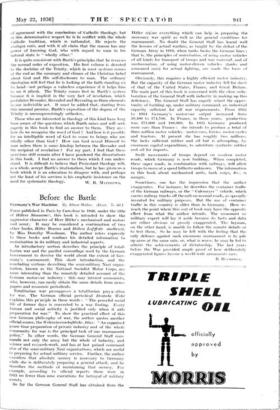• • Before the Battle
Germany's War Machine. By Albert Midler.. (Dent. 7s. 13(1.) Fuss published in Paris by Carrefour in 1036, under the title of Hitler* Stossartne:, this book is intended to show the aggressive' character of Herr Hitler's mechanised and motor- ised 'army.: It may be considered a continuation of two other books; Hitler Rearms and Hitters Luftilltle startbereit, by Miss Dorothy Woodman. The author refers expressly to these books and confines his detailed information to motorisation in its military and industrial aspects.
An introductory section describes the principle of total- itarian war and the pacifist camouflage used by the German Government to deceive the world about the extent of Ger- many's rearmament. This short introduction, and the concluding sections describing the semi-military Nazi organ- isation, known as the National Socialist Motor Corps, are more interesting than the minutely detailed account of the German motor-car industry : this may interest economists, who, however, can easily obtain the same details from news- papers and economic periodicals.
Totalitarian -war presupposes a totalitarian prel a ..lion for war. The German official periodical Deutsche !Fehr explains this prne:ple in these words : " The peaceful social life of former days is converted to a war footing. Every human and social activity is justified only when it aids preparation for war." To show the practical effect of this new German philosophy of war, the author quotes another official source, the Irehrwiseensehaftliehe Atlas: "An organised peace time preparation of private industry and of the whole community for war is the principal task of our rearmament policy." In other words, the German General Staff com- mands not only the army but the whole of industry, and sc ience and research-work, and has at last gained command alto of the semi-military Nazi organisations, which are useful in preparing for actual military service. Further, the author considers that absolute secrecy is necessary to Germany while she is deliberately -preparing a general attack, and he describes the methods of maintaining that secrecy. For example, according to official . reports there were in 1935 no fewer than nine executions -for betrayal of military
secrets. . , So far the German General Staff has' obtained from the
Hitler regime everything which:. can help in preparing the necessary war spirit as well as the general conditions for rearmament. No doubt the General Staff has learnt well the lessons of actual warfare, as taught by the defeat of the German Army in 1918, when tanks broke the German lines ; that is, the principles of tnotorisalion, of using motor vehicles of all kinds for transport of.troops and war material, and of mechanisation, of using motor-driven vehicles (tanks and armoured ears) for actual fighting, arc made the basis of rearmament.
Obviously, this requires a highly efficient motor industry. But the capacity of the German motor industry fell far short of that of the United States, France, and Great Britain. The main part of this book is concerned with the close colla- boration of the General Staff with industry in making up this deficiency. The General Staff has eagerly seized the oppor-
tunity of building up, ler military command, an industrial capacity sufficient for all war requirements. From 1932 to 1934 Germany's motor-car output increased from 50,4(X) to 174,700. In France, in those years, produet ion • was 171,000 and 188,000. In 1933 Germany produced. more cars than France : she .intends to produce a. total of three million motor vehicles—motor-ears, lorries, motor-cycles and tractors. At present she has roughly two millions. She lacks sufficient rubber and oil but is attempting, by enormous capital expenditure, to substitute synthetic rubber and oil for imports.
Swift movements of troops depend on modern motor roads, which Germany is now building. When completed, these super roads, in combination with railways, will allow roops to move at a speed hitherto unknown. The information in this book about mechanised units, tank corps, &e., is meagre.
Sometimes, one has the impression that. the author exaggerates. For instance, lie describes the container truffle of the German railways, or the " Culemeyer" vehicle, which carries railway trucks off the rails on normal roads, as specially • invented for military purposes. But the use of container traffic in this country is older than in Germany. Here we reach the point where this sort of book y have the opposite effect from what the author intends. The economist or military expert will lay it aside because its facts and data are either obvious or grossly exaggerated. The layman, on the other hand, is unable to follow the minute details or to test them.. So he may be left with the feeling that the only defence against such enormous rearmament is to pile up arms at the same rate, or, what is worse, he may be led to admire the achievements of dictatorship. The last years before the War provided ample proof of how deliberately exaggerated figures favour a world-wide armaments race.
13. Iluenion.z.


















































 Previous page
Previous page